4-Primary Color Wheel:
Ewald Hering's Color Chart

The 4-primary color wheel is not a color mixing wheel. It's not about mixing 3 primary colors as paints.
Instead, it shows how we see color, how our eyes and brains work.
Ewald Hering (1834-1918), a German physiologist and no relation of mine, published his 4-primary color wheel in 1878.
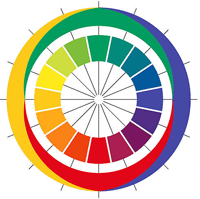
To this day, his model is ...
♦ very influential in the color/paint industries;
♦ great for understanding warm & cool colors, and
♦ full of gorgeous, 'eye candy' color combinations.
Hering added green to the other primary colors (yellow, blue and red), and called all four of them "psychological primaries".
Ewald Hering wasn't the first ...
... to identify four primary colors instead of three.
Before him, Leonardo da Vinci (1452-1519) had already classified yellow, blue, red & green as a basic set of 'simple' colors.
However, Leonardo didn't arrange these colors in a circular model. The 4-primary color wheel is Hering's invention.
The outer ring of Hering's color wheel is its most interesting feature: It shows how every primary color group (red, yellow, green, blue) has a warm and a cool side.
The crescents indicate how much warm or cool color has gone into the corresponding color patch on the color wheel chart:
- Warm red has a lot of yellow in it, cool red is bluish.
- Warm yellow tends toward red, cool yellow towards green.
- Warm green is yellowish, cool green has a blue bias.
- Warm blue (!!) tends towards red, cool blue is a bit green around the gills.
(You'll find more warm/cool diagrams on the warm & cool colors page.)
'Opposing' Colors Vs. Complementary Colors
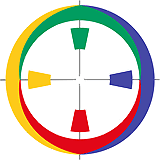
The 4-primary color wheel (here's a 'stripped' version) does not have complementary colors; Hering called his antagonists 'opposing' colors.
He argued (and was proven right, half a century after his death) that we physically see these primary colors as opposing pairs:
♦ red and green
♦ blue and yellow
♦ black and white
So what are the differences between opposing colors and complementary colors?
1
'Opposing' are colors that cannot be part of one another.
- Yellow can have a green or a red tinge, but never a blue tinge (there aren't any 'bluish yellows' or 'yellowish blues')
- Green can have a blue or a yellow tinge, but not a red tinge (there aren't any 'greenish reds' or 'reddish greens'.)
Complementary colors, on the other hand, 'complement' (=complete) each other only when they're mixed 1:1 - a completely different approach to Hering's color system.
2
Opposing and complementary colors are paired differently on their respective color wheels.
Here's a simplified version of the 3-primary and 4-primary color wheel chart. Compare the alignment of colors around the wheels: The only colors that face each other on both primary color wheel charts are red & green.
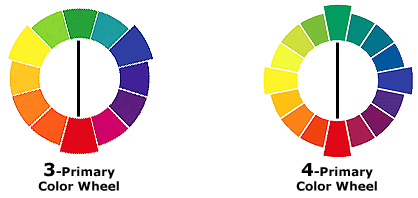
On the 4-primary color wheel, the color swatches squeeze together to allow for the newly expanded green section. This gives us a new set of lovely 'eye candy' opposites, like
- deep purple & lime,
- orange & turquoise,
- plum & lemon,
- cool green & orangey red.
Here's a range of opposing colors from the 4-primary color wheel:

Is One Primary Color Wheel Better Than The Other?
No. Neither of them is inherently more valid/important/useful than the other. They were just designed to answer completely different questions!
For interior design projects or crafts, I'd probably prefer Hering's 4-primary color wheel because of the way it 'explains' warm and cool colors. And also because of the lovely opposing pairs - they're just such a nice alternative to the color mixing wheel.
Download an image of Hering's 4-primary color wheel here!
Click A Pic For More Info:
If You Would Like To Buy A Color Wheel Chart ...
... welcome to my online Color Wheel Shop (in partnership with Amazon). I'm afraid, though, that these are all 3-primary color mixing wheels - they're still the best known and therefore more widely commercially available.
Yet to find the information you're looking for? Type a word or phrase into the search box below:
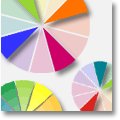
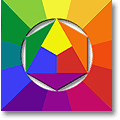
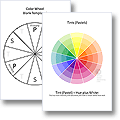
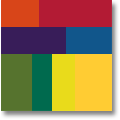

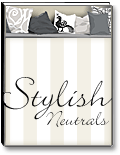
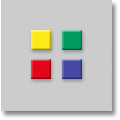
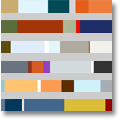
New! Comments
Have your say about what you just read! Leave me a comment in the box below.